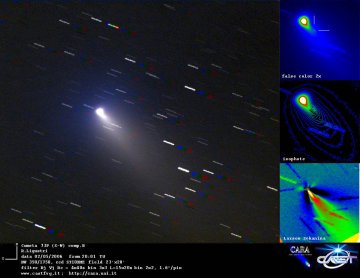 Roses. Candy. Spatulas? Make that the stars: Spaceweather PHONE for Mother's Day.
Roses. Candy. Spatulas? Make that the stars: Spaceweather PHONE for Mother's Day.
METEOR SHOWER: Earth is about to pass through a stream of dust from Halley's Comet, and this will produce the annual eta Aquarid meteor shower. It peaks on Saturday morning, May 6th: full story.
RED JR: Months after amateur astronomers discovered Jupiter's new red spot, Red Jr. has been photographed by the Hubble Space Telescope. It was worth the wait:

This wonderfully detailed image reveals a storm wider than Earth swirling around a turbulent brick-red core. Red Jr. is about half the size of its legendary cousin, the Great Red Spot. Both are visible in backyard telescopes this month as Jupiter executes a close encounter with Earth.
Last year Red Jr. was a different color: white. What happened? Researchers aren't sure what turned Red Jr. red. Some believe it is a sign of climate change on the solar system's biggest planet: more.
COMET OUTBURST: Fragment B of dying comet 73P/Schwassmann Wachmann is undergoing another outburst. Its brightness has jumped nearly 4-fold (1.5 visual magnitudes) during the past week.

Above: Bursting fragment B on May 2nd. Photo credit: Rolando Ligustri of Talmassons, Italy.
The cause of the outburst: Fragment B is falling apart, as shown in this photo from amateur astronomer Stefan Seip. When pieces fall off, fresh veins of ice and dust are exposed to sunlight, causing the ensemble to brighten.
Fragment B now glows like an 7th magnitude star and is an easy target for backyard telescopes. Look for it in the constellation Hercules around midnight.
Sky maps: May 5, May 6, May 7, May 8.

